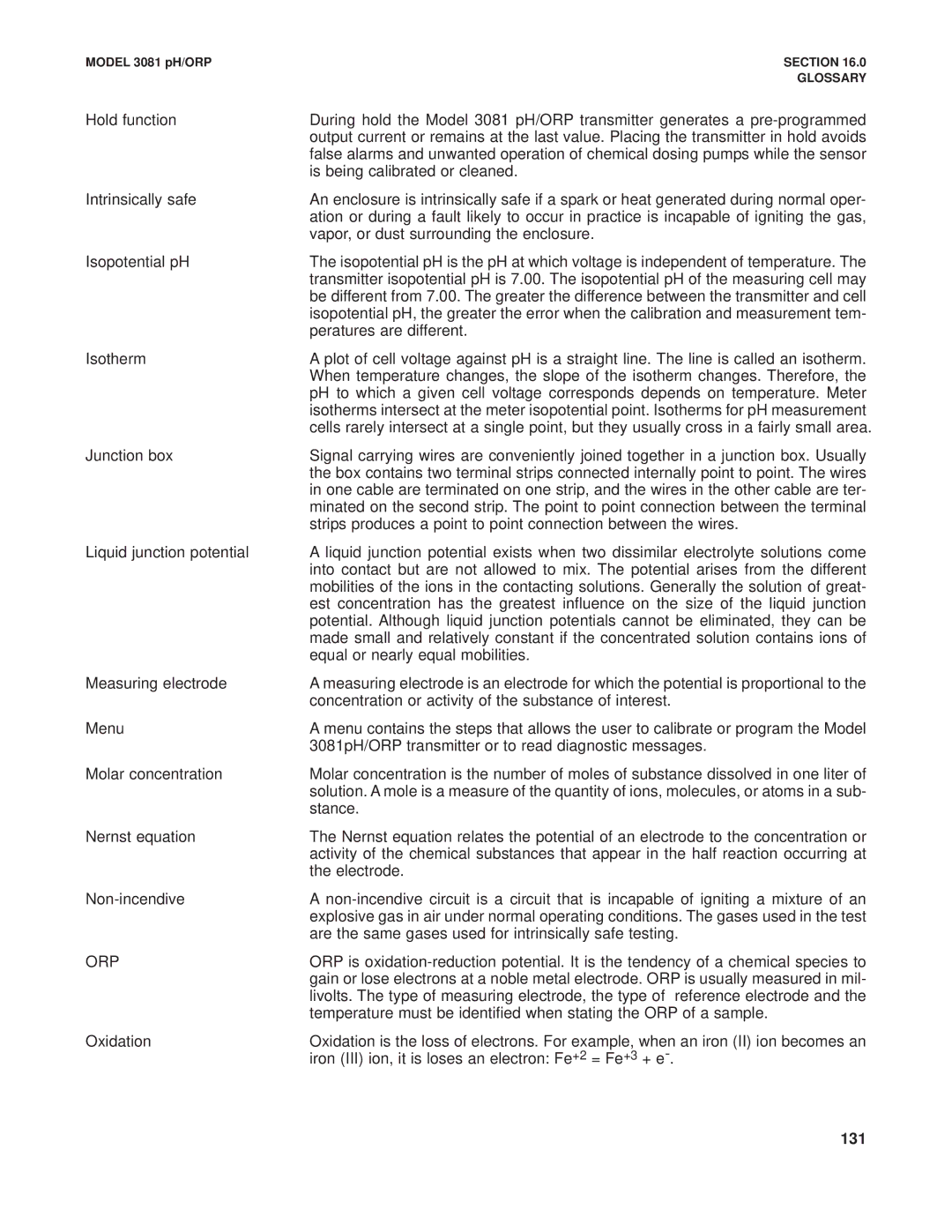MODEL 3081 pH/ORP | SECTION 16.0 |
| GLOSSARY |
Hold function | During hold the Model 3081 pH/ORP transmitter generates a |
| output current or remains at the last value. Placing the transmitter in hold avoids |
| false alarms and unwanted operation of chemical dosing pumps while the sensor |
| is being calibrated or cleaned. |
Intrinsically safe | An enclosure is intrinsically safe if a spark or heat generated during normal oper- |
| ation or during a fault likely to occur in practice is incapable of igniting the gas, |
| vapor, or dust surrounding the enclosure. |
Isopotential pH | The isopotential pH is the pH at which voltage is independent of temperature. The |
| transmitter isopotential pH is 7.00. The isopotential pH of the measuring cell may |
| be different from 7.00. The greater the difference between the transmitter and cell |
| isopotential pH, the greater the error when the calibration and measurement tem- |
| peratures are different. |
Isotherm | A plot of cell voltage against pH is a straight line. The line is called an isotherm. |
| When temperature changes, the slope of the isotherm changes. Therefore, the |
| pH to which a given cell voltage corresponds depends on temperature. Meter |
| isotherms intersect at the meter isopotential point. Isotherms for pH measurement |
| cells rarely intersect at a single point, but they usually cross in a fairly small area. |
Junction box | Signal carrying wires are conveniently joined together in a junction box. Usually |
| the box contains two terminal strips connected internally point to point. The wires |
| in one cable are terminated on one strip, and the wires in the other cable are ter- |
| minated on the second strip. The point to point connection between the terminal |
| strips produces a point to point connection between the wires. |
Liquid junction potential | A liquid junction potential exists when two dissimilar electrolyte solutions come |
| into contact but are not allowed to mix. The potential arises from the different |
| mobilities of the ions in the contacting solutions. Generally the solution of great- |
| est concentration has the greatest influence on the size of the liquid junction |
| potential. Although liquid junction potentials cannot be eliminated, they can be |
| made small and relatively constant if the concentrated solution contains ions of |
| equal or nearly equal mobilities. |
Measuring electrode | A measuring electrode is an electrode for which the potential is proportional to the |
| concentration or activity of the substance of interest. |
Menu | A menu contains the steps that allows the user to calibrate or program the Model |
| 3081pH/ORP transmitter or to read diagnostic messages. |
Molar concentration | Molar concentration is the number of moles of substance dissolved in one liter of |
| solution. A mole is a measure of the quantity of ions, molecules, or atoms in a sub- |
| stance. |
Nernst equation | The Nernst equation relates the potential of an electrode to the concentration or |
| activity of the chemical substances that appear in the half reaction occurring at |
| the electrode. |
A | |
| explosive gas in air under normal operating conditions. The gases used in the test |
| are the same gases used for intrinsically safe testing. |
ORP | ORP is |
| gain or lose electrons at a noble metal electrode. ORP is usually measured in mil- |
| livolts. The type of measuring electrode, the type of reference electrode and the |
| temperature must be identified when stating the ORP of a sample. |
Oxidation | Oxidation is the loss of electrons. For example, when an iron (II) ion becomes an |
| iron (III) ion, it is loses an electron: Fe+2 = Fe+3 + |
Page 145
Image 145
